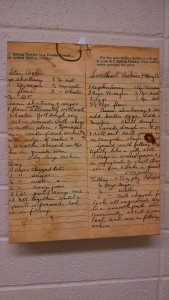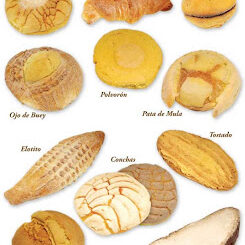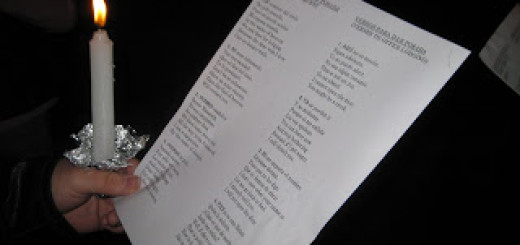LDS PIONEER RECIPES mid 1800’s
 DAUGHTERS OF THE UTAH PIONEERS
DAUGHTERS OF THE UTAH PIONEERS
Pioneer women who had to decide what few precious things to carry across the plains surely made one choice in common—their own individual collection of “receipts,” as recipes were then called. For them, these were reminders of a security left behind and a hope for the abundance of the future. In the interim, they simply did what they had to do to keep their families alive.
Many early memories of pioneer food concerned the frugality with which the Saints lived: “We lived on cornbread and molasses for the first winter.” “We could not get enough flour for bread … so we could only make it into a thin gruel which we called killy.” “Many times … lunch was dry bread … dipped in water and sprinkled with salt.” “These times we had nothing to waste; we had to make things last as long as we could.”*
No doubt the “receipt” books were closed during these times, and efforts were given simply to finding food and making it go as far as possible.
But slowly, even out of this deprivation, recipes grew. The pioneer women learned to use any small pieces of leftover meat and poultry with such vegetables as they might have on hand—carrots, potatoes, corn, turnips, onions—to make a pie smothered with Mormon gravy.
Thrift fritters were a combination of cold mashed potatoes and any other leftover vegetables and/or meat, onion for flavoring, a beaten egg, and seasonings, shaped into patties and browned well on both sides in hot drippings.
One Danish immigrant mother made “corn surprises” to brighten up the scanty diet of bread and molasses. To corn soup, made with ground dried corn, she added anything colorful or tasty that she could find: bits of parsley or wild greens, carrots, sweet peppers, chips of green string beans, chopped whites or yolks of hard-cooked eggs, or a little bit of rice.
While the first few companies of pioneers were comprised mostly of New Englanders, other states were sparsely represented, as were Canada, England, Scotland, Wales, the Isle of Man, Scandinavia, Germany, and even Spain and Australia. Within the next five years thousands more from other European countries poured into Zion. And with them came their favorite national recipes.
By the time these immigrants arrived, the critical food shortages were somewhat alleviated, with most families having access to milk and cream, butter and cheese, beef, lamb, pork, chicken, eggs, flour ground from their own wheat harvest, molasses and honey, and a little later, sugar.
Undoubtedly recipes passed from hand to hand. Recipes for steamed Boston brown bread were probably exchanged for those for Oklahoma graham gems, while German Saints taught the Welsh how to make their spiced red cabbage and learned in return how to make Welsh currant bread. Truly, the cooking pot of the early pioneers was a melting pot for many kinds of cooking from many countries and ranged from the simplest and most humble of recipes to elaborate and elegant dishes from the kitchens of European kings.
Early diaries are filled with happy reminiscences of work and fun: salt-rising bread mixed in mother’s “baking kettle” while traveling in the wagon, then baked over the campfire at night; bacon and sour-dough pancakes cooked over campfires; molasses taffy pulls made possible by generous dippings from the skimmings of molasses boilers; peach preserves cooked in the last of the molasses batch and stored in big barrels; fruits and vegetables dried for winter storage; buffalo pie and wild berries; raspberry and currant and gooseberry bushes planted near the house, yielding fruit quickly and easily.
Chickens were brought across the plains as early as 1847. A favorite among early recipes was velvet chicken soup, brought to the valley by an early English convert.
Velvet Chicken Soup
3 quarts cold water
1 tablespoon salt
6 peppercorns (or 1/4 teaspoon white pepper)
1 small onion, chopped
2 tablespoons chopped celery
2 cups rich milk or cream
1 tablespoon cornstarch
1 tablespoon butter
Salt and pepper
2 eggs, well beaten
Thoroughly clean chicken and cut into pieces. Put in covered kettle with cold water and salt. Bring to boil quickly and simmer until chicken is tender. Remove chicken from stock and remove meat from bones (saving meat to use in croquettes, pie, etc.) Return bones to soup stock and add peppercorns (or white pepper), chopped onions, and chopped celery. Simmer together until a little more than a quart of stock remains in pan; strain, cool, and remove all fat. Add rich milk or cream, bring to a boil, and thicken with cornstarch that’s been mixed smooth with a little cold water. Add butter and season to taste. Beat eggs with a little cream. Pour 1 cup soup over egg mixture, stirring well, then pour egg-soup mixture back into soup, stirring constantly, and cook 2 minutes. Serve hot in soup dishes, adding bite-size croutons if desired.
Side Pork and Mormon Gravy
Mormon gravy, common fare among the early settlers and apparently a creation of necessity expressly for the times, is still hearty and nourishing for many of this generation who like to make it with ground beef or frizzled ham or bacon and serve it over baked potatoes.
4 tablespoons meat drippings
3 tablespoons flour
2 cups milk
Salt, pepper, paprika
Cook meat on both sides in heavy frying pan until crisp. Remove from pan and keep warm. Measure fat and return desired amount to skillet. Add flour and brown slightly. Remove from heat and add milk, stirring well to blend. Return to heat and cook and stir until mixture is thick and smooth. Season to taste. Serve with side pork on potatoes, biscuits, cornbread, or even pancakes.
The years 1862 and 1863 saw thousands of Scandinavian Saints leaving their homeland to come to Zion. With them came some of their favorite recipes, including Norwegian fruit soup and Swedish jam cake.
Norwegian Fruit Soup
2 prunes
1 tablespoon dried currants
1 tablespoon raisins
1-inch stick cinnamon
1 1/2 teaspoons sugar
1/2 teaspoon vinegar
1 1/2 teaspoons sago or quick-cooking tapioca
To each cup water, add amounts given above of prunes, currants, raisins, and cinnamon. Cook until fruit is tender. Add sugar, vinegar, and sago or tapioca and bring to a full rolling boil. Remove from heat, remove stick cinnamon, and allow to stand for a few minutes before serving.
Swedish Jam Cake
1 1/4 cups sugar
3 eggs, separated
Pinch salt
1 teaspoon soda
1 cup buttermilk
2 1/2 cups sifted flour
1/2 teaspoon cinnamon
1/4 teaspoon cloves
1/2 teaspoon allspice
1 cup strawberry jam
Cream butter and sugar; add beaten egg yolks and salt. Dissolve soda in buttermilk. Sift together flour and spices and add to creamed mixture alternately with buttermilk, adding flour last. Beat well and add jam. Fold in beaten egg whites. Bake in greased and floured 8×8-inch pan at 375° F. for 35 to 40 minutes.
Native Currant Whirligig
Of English origin, “currant whirligig” was made in pioneer times with native wild currants. It is equally good made with other tart berries, such as cranberries.
2 tablespoons flour
1 teaspoon cinnamon
1/2 teaspoon grated nutmeg
1/2 teaspoon salt
1 cup hot water
3 cups cleaned and washed black or red currants (or other tart berries)
Mix sugar, flour, spices, and salt together. Pour slowly into hot water, stirring constantly. (If using honey, use cold rather than hot water and blend ingredients together before heating.) Cook until thickened, stirring. Place currants in 8×8-inch square pan or baking dish and pour hot sauce over them. Set into preheated 350° F. oven while making topping.
Topping
3/4 teaspoon soda
1 1/2 teaspoons baking powder
3/4 teaspoon salt
1 teaspoon sugar
1/4 cup lard or shortening
1 large egg
3 tablespoons milk (soured with 1/2 teaspoon vinegar)
1/4 cup sugar or honey
3 tablespoons melted butter
Sift flour, soda, baking powder, salt, and sugar into mixing bowl. Cut in shortening, then add egg and milk. Mix to stiff dough. Roll into 9×12-inch rectangle; spread with honey and melted butter mixture. Roll from long side as for a jelly roll, pinching edges, and cut into 9 pieces. Remove berry sauce from oven and place dough swirls at even intervals on top of hot fruit filling. Bake at 350° F. for 15 minutes. Serve warm with or without whipped cream.
Spiced Red Cabbage
Typically German, this recipe for spiced red cabbage has been passed down as a favorite. It is still used in many homes today, traditionally in some as part of the Christmas feast.
2 onions, thinly sliced
1 medium-sized apple
1 small potato, sliced
2 tablespoons vinegar
1/4 cup sugar
1/4 teaspoon cloves
1/2 teaspoon salt
1/8 teaspoon pepper
1 tablespoon shortening
Combine cabbage, onion, apple, and potato in small amount of boiling salted water and simmer until tender. Drain and combine with remaining ingredients.
Currant Bread
This currant bread recipe was brought from Wales in 1856. The Welsh people often used it as a Christmas bread. The Saints found wild currants when they first arrived in the valley, and it is possible that they dried them for winter use. Raisins were not available until later, when cuttings for grapes were brought from California.
1/4 cup lukewarm water
9 cups flour
2 cups shortening
1 pound raisins
1 pound dried currants
1 1/2 cups sugar
1/2 cup molasses
3 halves candied lemon peel, cut fine
1 tablespoon nutmeg
1 tablespoon salt
3 cups (about) water
Soften yeast in 1/4 cup lukewarm water. Cut shortening into flour. Add remaining ingredients, including yeast mixture, except water. Mix thoroughly, then add enough warm water (about 3 cups) to make a soft but not sticky dough. Let rise overnight (about 7 hours), then form into 4 small loaves. Let rise again (about 2 hours) and bake at 300° F. for 1 1/2 hours. Especially good with cheese.
Potato Cakes
This potato cake recipe came across the plains with a young woman from Austria over a hundred years ago. Potato cakes are delicious served hot or cold with any kind of meat, fish, poultry, or salad.
2 teaspoons salt
1/2 cup milk
2 eggs
1 cup flour
Shortening
Wash and peel potatoes, then grate medium fine. Combine with salt, milk, eggs, and flour. Drop mixture by spoonfuls into hot shortening in skillet and fry to golden brown on both sides.
With the wild fruits—plums, cherries, grapes, gooseberries, currants—and the glorious fresh fruit cultivated so successfully from imported cuttings, the early pioneer women were soon making some of the delicacies that reminded them of “home.” Two of the favorites were Swiss apple-cherry pie, a recipe that came into the valley with a young Swiss convert who was famed for its making, and 101-year-old pastry, as good today as it was in the early days.
Swiss Apple-Cherry Pie
6 tablespoons butter
2 1/2 cups pitted sour pie cherries, fresh or canned
1 cup sugar
2 tablespoons flour
2 teaspoons ground cinnamon
1/2 teaspoon grated nutmeg
Make pastry for two-crust pie. Pare, core, and slice apples. Melt 2 tablespoons butter and brush on bottom of pastry shell. Arrange a layer of apples on bottom of pastry shell. Mix dry ingredients and sprinkle portion over layer of apples. Arrange layer of red cherries, then sprinkle with some of dry ingredients; then layer of apples and dry ingredients; layer of cherries and dry ingredients; and end with layer of apples. Top with dots of remaining butter. After top crust is added to pie, rub crust with cream or evaporated milk and sprinkle with mixture of 1/2 teaspoon sugar and 1/4 teaspoon ground cinnamon. Bake at 425° F. for 30 to 40 minutes.
101-Year-Old Pastry
1/2 teaspoon salt
1 cup lard or shortening
1 egg, beaten
1 tablespoon vinegar
Cold water
Cut shortening into flour and salt. Beat egg lightly in a 1 1/2-cup measure; add vinegar and fill cup with cold water. Add just barely enough liquid to dry ingredients to hold dough together—about 4 tablespoons—reserving remaining liquid for next batch of pastry. Handle dough as little as possible. Roll out into pastry and use as desired. Makes two 9-inch pie shells.
1 1/2 cups sugar
2 eggs
3 tablespoons butter
1 1/2 teaspoons nutmeg
1/2 teaspoon baking soda
1/4 teaspoon baking powder
1/2 teaspoon salt
flour
1 1/4 cups cold applesauce
2 cups sugar
1 cup chopped nuts
1 tablespoon vanilla
1 1/2 cups sour milk
1/3 cup sugar
1/4 cup melted shortening
1 well-beaten egg
1 teaspoon baking soda
1 teaspoon baking powder
1/2 teaspoon salt
1 cup flour
1 cup shortening
4 cups flour
1 3/4 cup sugar
1 cup finely chopped almonds
1 tablespoon vanilla
1 cup flour
2 teaspoons baking soda
1 teaspoon salt
2 tablespoons molasses
3 cups buttermilk
2 well-beaten eggs
1 cup white sugar
1 cup shortening
2 eggs
1 teaspoon baking soda
1/4 cup boiling water
1 cup shredded coconut
1 teaspoon vanilla
4 1/2 cups flour
1/4 teaspoon salt
1 1/2 teaspoons baking powder
1 teaspoon baking powder
1/2 teaspoon ground cloves
1 teaspoon cinnamon
3/4 teaspoon salt
3/4 cup shortening
2 cups brown sugar
2 separated eggs
1 teaspoon soda
1 1/4 cups sour milk
1 teaspoon vanilla
1/2 cup chopped nuts
1 cup rolled oats
1/2 cup shortening
2 cups buttermilk, yogurt, cream, or sweet milk
1 teaspoon salt
1 teaspoon baking soda


